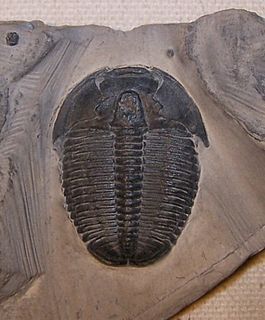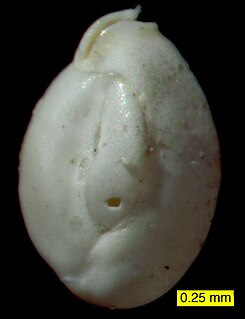
The Globigerinina is a suborder of foraminiferans that are found as marine plankton. They produce hyaline calcareous tests, and are known as fossils from the Jurassic period onwards. The group has included more than 100 genera and over 400 species, of which about 30 species are extant. One of the most important genera is Globigerina; vast areas of the ocean floor are covered with Globigerina ooze, dominated by the shells of planktonic forms.

Ptychopariida is a large, heterogeneous order of trilobite containing some of the most primitive species known. The earliest species occurred in the second half of the Lower Cambrian, and the last species did not survive the Ordovician–Silurian extinction event.

The Miliolida are an order of foraminifera with calcareous, porcelacous tests that are imperforate and commonly have a pseudochitinous lining. Tests are composed of randomly oriented calcite needles that have a high proportion of magnesium along with organic material. Tests lack pores and generally have multiple chambers.

The Rotaliida are an order of Foraminifera, characterized by multilocular tests (shells) composed of bilamellar perforate hyaline lamellar calcite that may be optically radial or granular.
Hantkeninoidea is a superfamily of foraminifera with planispiral or enrolled biserial tests, found in marine sediments of Paleocene to Miocene age, in which chambers vary from globular to elongate and the primary aperture is equatorial in position. It contains one family, the Hantkeninidae.
Involutinida is an order of foraminifera included in the Spirillinata found in the fossil record from the early Permian to early Late Cretaceous (Cenomanian).

Cibicides is a genus of cosmopolitan benthic foraminifera known from at least as far back as the Paleocene that extends down to the present.
The Cassidulinacea is a superfamily of benthic amoeboid foraminifera in the order Rotaliida that has been extant from the Paleocene down to the present. Tests are composed of secreted, optically radial or granular, perforate calcite with chambers biserially coiled at least in the early part, Apertures are usually an interiomarginal slit, but may become terminal and may have secondary features.
The Globoroatioidea constitutes a superfamily of Cenozoic plantonic foraminifera. It is part of the suborder Globigerinina. Globoroatioidea have trochospiral tests with rounded to carinate peripheries, the walls of which are of finely lamellar, perforate, of optically radial calcite, with an inner organic lining. The surface of these tests is smooth, lacking spines, but may be covered with pustules or pitted, and may have one or more large pores at the center. There is a single primary aperture that may be bordered by an imperforate lip, as well as possible supplementary apertures.
Globigerinana are free living pelagic foraminiferan, included in the class Rotaliata that range from the Jurassic to recent. Test are commonly planospiral or trochospiral but may be uniserial to multiserial and are of secreted hyaline (glassy) calcite. Chambers are flattened in planospiral forms and spheroidal in trochospiral and serial forms. Some have long radial spines, or needles that may be solidly fixed or moveable in sockets. Gametes are biflagellate and are produced in greater number than by bottom dwelling benthic forms.

Cuneolinidae is an extinct family of prehistoric foraminifera in the order Loftusiida, in the suborder Ataxophragmiina and superfamily Ataxophragmioidea.
Cassigerinellidae is an extinct family of foraminifera belonging to the superfamily Guembelitrioidea and the suborder Globigerinina.
Cassigerinella is an extinct genus of foraminifera belonging to the family Cassigerinellidae of the superfamily Guembelitrioidea and the suborder Globigerinina. Its type species is Cassigerinella chipolensis.
Acarinina is an extinct genus of foraminifera belonging to the family Truncorotaloididae of the superfamily Globorotalioidea and the suborder Globigerinina. Its fossil range is from the upper Paleocene to the middle Eocene. Its type species is Acarinina nitida.
Heterohelix is an extinct genus of foraminifera belonging to the family Heterohelicidae of the superfamily Heterohelicoidea and the suborder Globigerinina. Its type species is Heterohelix americana.
Truncorotaloididae is a family of foraminifera belonging to the superfamily Globorotalioidea in the suborder Globigerinina and the order Rotaliida. It is found in marine sediments from the middle Paleocene to the upper Eocene.
Loeblichella is a genus of foraminifera belonging to the family Globotruncanidae of the superfamily Globotruncanoidea and the suborder Globigerinina. Its type species is Loeblichella hessi. The genus was named and first described by Pessagno in 1967. Its fossil range is the Late Cretaceous Period.
Praeglobotruncana is an extinct genus of foraminifera belonging to the family Hedbergellidae of the superfamily Rotaliporoidea and the suborder Globigerinina. Its type species is Praeglobotruncana delrioensis. Its fossil range is the Cretaceous Period.
Heterohelicidae is a family of foraminifera belonging to the superfamily Heterohelicoidea and the suborder Globigerinina.
Hedbergellidae is an extinct family of foraminifera belonging to the superfamily Rotaliporoidea and the suborder Globigerinina.






